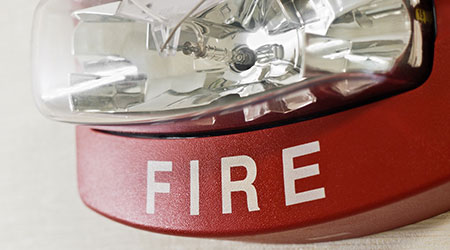Q: Ever since I've been working in healthcare, I keep hearing about fire alarm strobes being required in offices with more than one person. In other words, if there's a one-person office, and a second desk and worker is brought in, a strobe is now required. I've been digging all over NFPA 72 2010, NFPA 101 2012, IFC 2012, and IBC 2012, and I just can' seem to find it - maybe I'm just missing it. I've also seen it mentioned in other online forums, but nothing specific other than "requires it." Can you provide guidance?
A: There are two code applications here. Since strobes are intended for the hearing impaired, you’ll find general placement requirements in the ADAAG. Because it is not always possible to fix the occupancy of a room or space or anticipate its use by a person with a hearing impairment, visual alarms are required in every common use room or space in facilities equipped with an emergency alarm system. This is particularly important in those common use spaces where a person may be alone. ADAAG 4.28.1 General stipulates that alarm systems required to be accessible shall provide visible signals in restrooms, in other general and common use areas, and in hallways and lobbies.
Common use areas also include meeting and conference rooms, classrooms, cafeterias, filing and photocopy rooms, employee break rooms, dressing, examination, and treatment rooms, and similar spaces that are not used solely as employee work areas. ADAAG does not require that areas used only by employees as work areas be fully accessible. Therefore, visual alarms are not required in individual employee offices and work stations. Having two persons in an office does not make that an area of congregation or a common use area.
The other code consideration is private mode signaling in healthcare facilities. If the facility is a non-evacuation/partial relocation facility, the intent of notification is to the in-house responding personnel, not the general public. In private mode signaling, placement of notification devices are only required in areas where responders may be located (nurse stations, back of the house areas and areas of employee common use).
Unless the local AHJ has a code amendment on the books, many times the entity that’s requiring this is misinformed and will relent once made aware. It’s not a quantity thing; it’s a "use" thing.
Gene Rowe, Director of Business Development at Affiliated Fire Systems, Inc. provided the answer to this question
Brad Keyes, CHSP, is the owner of KEYES Life Safety Compliance, and his expertise is in the management of the Life Safety Program, including the Environment of Care and Emergency Management programs.

 Grounding Healthcare Spaces in Hospitality Principles
Grounding Healthcare Spaces in Hospitality Principles UC Davis Health Selects Rudolph and Sletten for Central Utility Plant Expansion
UC Davis Health Selects Rudolph and Sletten for Central Utility Plant Expansion Cape Cod Healthcare Opens Upper 2 Floors of Edwin Barbey Patient Care Pavilion
Cape Cod Healthcare Opens Upper 2 Floors of Edwin Barbey Patient Care Pavilion Building Sustainable Healthcare for an Aging Population
Building Sustainable Healthcare for an Aging Population Froedtert ThedaCare Announces Opening of ThedaCare Medical Center-Oshkosh
Froedtert ThedaCare Announces Opening of ThedaCare Medical Center-Oshkosh